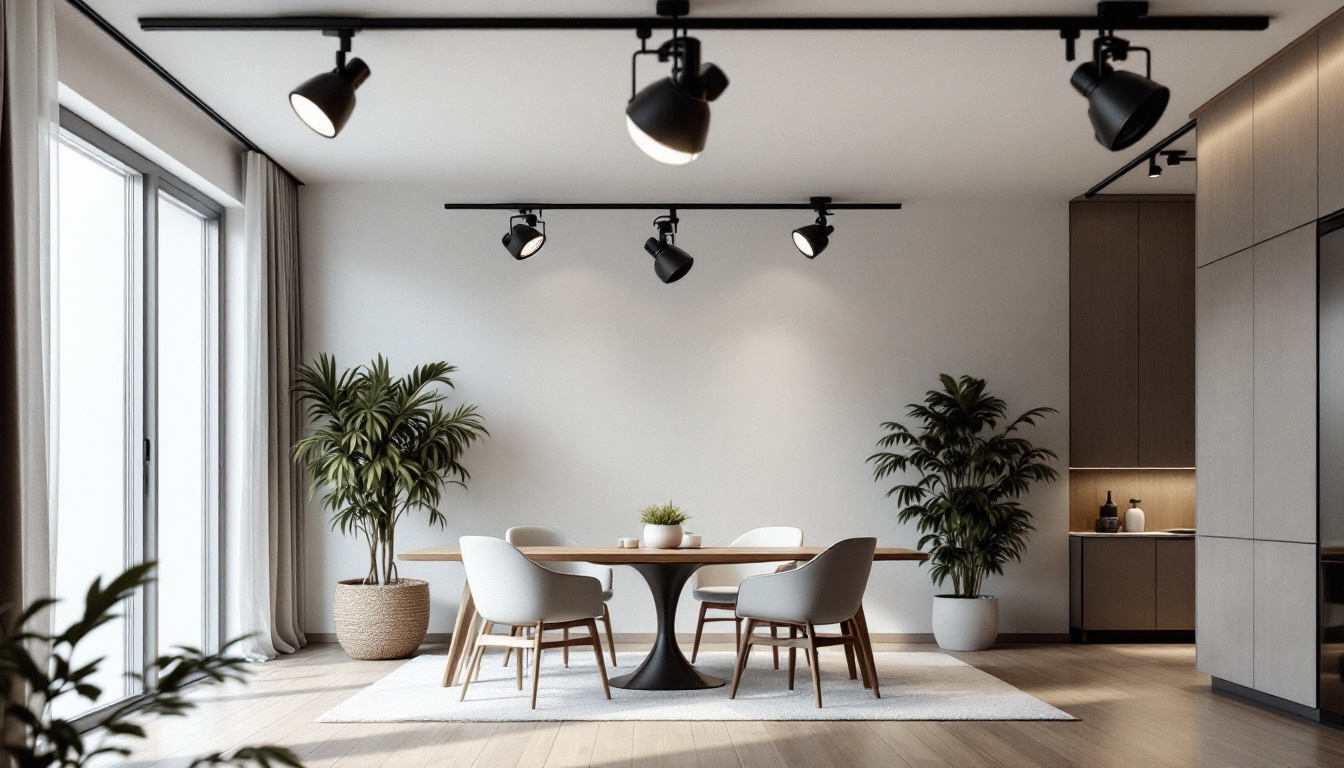

Lighting plays a crucial role in enhancing the aesthetics and functionality of spaces. For lighting contractors, understanding the various track lighting track types is essential for delivering effective solutions to clients. This article delves into the different types of track lighting systems available, their applications, and why this knowledge is vital for professionals in the field.
Track lighting is a versatile and flexible lighting solution that allows for the adjustment and positioning of light fixtures along a track. This system is particularly popular in both residential and commercial settings due to its adaptability and ease of installation. By offering a range of lighting options, track lighting can highlight specific areas, create ambiance, and improve overall space functionality.
For lighting contractors, the ability to recommend and install the right type of track lighting can significantly impact the success of a project. Understanding the nuances of different track types, their configurations, and their compatibility with various fixtures is essential for achieving optimal results.
Track lighting systems consist of several key components, including the track itself, the fixtures, and the power supply. The track serves as the backbone of the system, providing a pathway for the electrical current and allowing fixtures to be mounted and repositioned as needed.
Fixtures are the individual light sources that attach to the track. They come in various styles, such as spotlights, floodlights, and pendants, allowing for diverse lighting effects. The power supply connects the track to the electrical system, ensuring that the fixtures receive the necessary energy to operate.
There are several types of track lighting tracks available, each with its unique characteristics and applications. Understanding these types helps contractors select the most suitable option for their projects.
The H-type track, also known as the Halo track, is one of the most common types used in residential and commercial applications. It features a distinctive “H” shape and is compatible with a wide range of fixtures. This track type allows for easy installation and flexibility in fixture placement.
One of the key advantages of the H-type track is its versatility. Contractors can easily mix and match fixtures, making it ideal for spaces that require varied lighting options. Additionally, the H-type track is available in different finishes, allowing for customization to match the design aesthetic of the environment.
The J-type track, or Juno track, is another popular option among lighting contractors. It has a unique “J” shape and is specifically designed for use with Juno fixtures. This track type is known for its durability and reliability, making it suitable for high-traffic areas.
One of the standout features of the J-type track is its ability to accommodate a wide range of fixture styles, including LED options. This flexibility allows contractors to provide energy-efficient solutions while still meeting the aesthetic needs of their clients.
The L-type track, or Lightolier track, features an “L” shape and is often used in commercial settings. This track type is designed for specific fixtures, offering a streamlined approach to lighting design. It is particularly effective in environments where uniform lighting is essential, such as galleries and retail spaces.
Contractors appreciate the L-type track for its sleek design and ease of installation. It allows for a clean and modern look while providing ample lighting coverage. Additionally, the L-type track is compatible with various dimming systems, enhancing its versatility in different applications.
Choosing the right track lighting type is not just about aesthetics; it significantly impacts functionality, energy efficiency, and overall project success. Here are several reasons why understanding track types is crucial for lighting contractors.
Each track type has specific compatibility requirements with fixtures. Knowing which fixtures work with each track type ensures that contractors can provide clients with the best options for their needs. This knowledge prevents potential issues during installation and helps avoid costly mistakes.
For instance, using an H-type track with Juno fixtures may lead to installation challenges and performance issues. Understanding the nuances of track compatibility allows contractors to streamline their processes and enhance client satisfaction.
Different track types offer varying levels of design flexibility. Some tracks allow for more customization in terms of fixture placement and orientation, while others may be more restrictive. By understanding the design capabilities of each track type, contractors can better meet the specific lighting needs of their clients.
For example, if a client desires a dynamic lighting scheme that can be easily adjusted, an H-type track may be the best option. Conversely, if uniform lighting is the priority, an L-type track may be more appropriate. This understanding enables contractors to provide tailored solutions that align with client expectations.
Energy efficiency is a growing concern in the lighting industry, and track type plays a significant role in this aspect. Some track types are better suited for energy-efficient fixtures, such as LEDs, while others may not support these technologies as effectively.
By selecting the appropriate track type, contractors can help clients achieve their energy efficiency goals. This not only benefits the environment but can also lead to cost savings for clients in the long run. Understanding the energy implications of different track types is essential for contractors who want to remain competitive in the market.
Proper installation is crucial for the successful operation of track lighting systems. Lighting contractors should be aware of various installation considerations to ensure optimal performance and safety.
Before installation, contractors must assess the electrical requirements of the track lighting system. This includes determining the voltage, wattage, and circuit capacity needed to support the fixtures. Proper electrical planning ensures that the system operates efficiently and reduces the risk of overloads or failures.
Additionally, understanding local electrical codes and regulations is essential for compliance and safety. Contractors should always stay updated on these requirements to avoid legal issues and ensure the safety of their installations.
Track lighting systems can be mounted in various ways, including ceiling-mounted, wall-mounted, or suspended options. The choice of mounting method depends on the specific application and design preferences. Contractors should evaluate the space and determine the most suitable mounting option for optimal lighting performance.
For instance, in spaces with high ceilings, suspended mounting may be more effective in providing adequate lighting coverage. Conversely, wall-mounted options may be ideal for smaller areas where ceiling space is limited. Understanding these mounting options allows contractors to provide tailored solutions that enhance the overall lighting experience.
Proper fixture positioning is key to achieving the desired lighting effects. Contractors should consider factors such as beam angle, spacing, and the intended use of the space when positioning fixtures along the track. This attention to detail can significantly impact the overall lighting quality and client satisfaction.
For example, in a gallery setting, fixtures may need to be positioned to highlight specific artworks, while in a retail environment, fixtures should be strategically placed to enhance product visibility. Understanding the nuances of fixture positioning enables contractors to create effective lighting schemes tailored to the specific needs of each project.
As the lighting industry evolves, new trends in track lighting continue to emerge. Staying informed about these trends can help contractors offer innovative solutions to their clients.
Smart technology is transforming the way lighting systems operate, and track lighting is no exception. Smart track lighting systems allow for remote control, dimming, and scheduling through mobile devices or smart home systems. This level of control enhances user experience and energy efficiency.
Contractors who are knowledgeable about smart track lighting options can provide clients with cutting-edge solutions that align with modern lifestyle preferences. This trend is particularly appealing to tech-savvy clients looking to integrate their lighting systems with other smart home technologies.
Minimalism continues to be a popular design trend, and track lighting systems are adapting accordingly. Sleek, unobtrusive track designs that blend seamlessly with the surrounding architecture are gaining traction. These minimalist options provide effective lighting without detracting from the overall aesthetic of the space.
Contractors should be aware of the growing demand for minimalist track lighting solutions and be prepared to offer stylish options that align with this trend. This knowledge can help contractors stay competitive in a design-conscious market.
With a growing emphasis on sustainability, many clients are seeking eco-friendly lighting solutions. Track lighting systems that support energy-efficient fixtures, such as LEDs, are becoming increasingly popular. Additionally, manufacturers are focusing on sustainable materials and production methods for track lighting components.
Contractors who prioritize sustainability in their offerings can appeal to environmentally conscious clients and contribute to a greener future. Understanding the sustainable options available in track lighting can set contractors apart in a competitive landscape.
For lighting contractors, understanding the various track lighting track types is essential for delivering effective, tailored solutions to clients. Each track type offers unique characteristics, compatibility, and design flexibility that can significantly impact the success of a project.
By staying informed about the different track types, installation considerations, and emerging trends, contractors can enhance their expertise and provide clients with innovative lighting solutions. Ultimately, a deep understanding of track lighting systems not only benefits contractors but also leads to satisfied clients and successful projects.
Ready to elevate your lighting projects with the highest quality track lighting solutions? Look no further than LumenWholesale, where we provide contractors with spec-grade lighting products at unbeatable wholesale prices. Our extensive selection is designed to meet the most rigorous industry standards, ensuring you deliver reliable and high-performance lighting to your clients. With free shipping on bulk orders, you can access premium lighting at the best value — all without hidden fees or compromises. Don’t let middleman markups affect your bottom line. Choose LumenWholesale for quality, affordability, and convenience. Wholesale Lighting at the Best Value is just a click away.

Explore the fascinating journey of standard light bulbs and their transformative impact on the lighting industry.

Discover why purchasing decorative LED bulbs in bulk from local distributors might not be the best choice.

Discover the perfect lighting for your space with expert insights from top lighting contractors.

Discover why opting for local distributors might not be the best choice when purchasing commercial sign lights in bulk.
Get notified when NEW deals are released.
Optimize your budget with wholesale discounts.
Only top-quality, specification-grade lighting products.
No additional costs at checkout - what you see is what you pay.
We understand the unique needs of contractors.